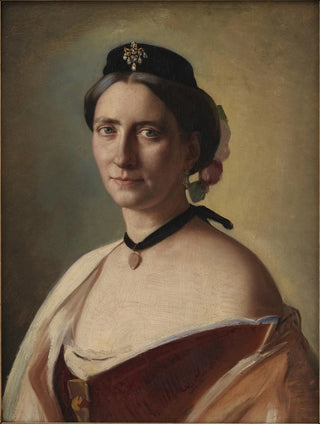Art print | L'épouse de l'artiste, Mme Alma Bloch née Trepka - Carl Bloch


View from behind

Frame (optional)
In the fascinating world of art, some works manage to capture not only the essence of their subjects but also the intimacy of human relationships. "L'épouse de l'artiste, Mme Alma Bloch née Trepka - Carl Bloch" is one of those creations that transcend the simple portrait to become a true testament to love and the connection between the artist and his model. This piece, imbued with delicacy and sensitivity, invites the viewer to delve into Carl Bloch's personal universe while offering a glimpse of the timeless beauty of his muse. Contemplating this art print evokes a palpable emotion, as if being transported into the artist's studio, witnessing a moment frozen in time.
Style and uniqueness of the work
Carl Bloch's style is characterized by an exceptional mastery of light and shadow, as well as meticulous attention to detail. In this work, the chosen color palette evokes a soft and soothing atmosphere, where each hue seems to play a role in the visual storytelling. The face of Mme Alma Bloch, with her serene and contemplative expression, is surrounded by a harmonious composition that highlights her presence without ever overwhelming it. The drapery of her dress, carefully painted, adds a tactile dimension to the piece, encouraging the viewer to imagine touching the luxurious fabrics. The way Bloch captures the psychology of his wife, both woman and muse, demonstrates a deep understanding of humanity. Every brushstroke appears charged with emotion, making this portrait not only a representation but a true ode to femininity.
The artist and his influence
Carl Bloch, a Danish painter of the 19th century, is often celebrated for his ability to marry realism and romanticism in his works. His artistic training, influenced by Renaissance masters, allowed him to develop a unique style that marked his era. Bloch established himself as a leading artist, notably through his religious works and portraits. His introspective approach and sensitivity to the beauty of everyday life enabled him

Matte finish

View from behind

Frame (optional)
In the fascinating world of art, some works manage to capture not only the essence of their subjects but also the intimacy of human relationships. "L'épouse de l'artiste, Mme Alma Bloch née Trepka - Carl Bloch" is one of those creations that transcend the simple portrait to become a true testament to love and the connection between the artist and his model. This piece, imbued with delicacy and sensitivity, invites the viewer to delve into Carl Bloch's personal universe while offering a glimpse of the timeless beauty of his muse. Contemplating this art print evokes a palpable emotion, as if being transported into the artist's studio, witnessing a moment frozen in time.
Style and uniqueness of the work
Carl Bloch's style is characterized by an exceptional mastery of light and shadow, as well as meticulous attention to detail. In this work, the chosen color palette evokes a soft and soothing atmosphere, where each hue seems to play a role in the visual storytelling. The face of Mme Alma Bloch, with her serene and contemplative expression, is surrounded by a harmonious composition that highlights her presence without ever overwhelming it. The drapery of her dress, carefully painted, adds a tactile dimension to the piece, encouraging the viewer to imagine touching the luxurious fabrics. The way Bloch captures the psychology of his wife, both woman and muse, demonstrates a deep understanding of humanity. Every brushstroke appears charged with emotion, making this portrait not only a representation but a true ode to femininity.
The artist and his influence
Carl Bloch, a Danish painter of the 19th century, is often celebrated for his ability to marry realism and romanticism in his works. His artistic training, influenced by Renaissance masters, allowed him to develop a unique style that marked his era. Bloch established himself as a leading artist, notably through his religious works and portraits. His introspective approach and sensitivity to the beauty of everyday life enabled him






